Spotlight on Sean Proctor
Feb 1, 2014
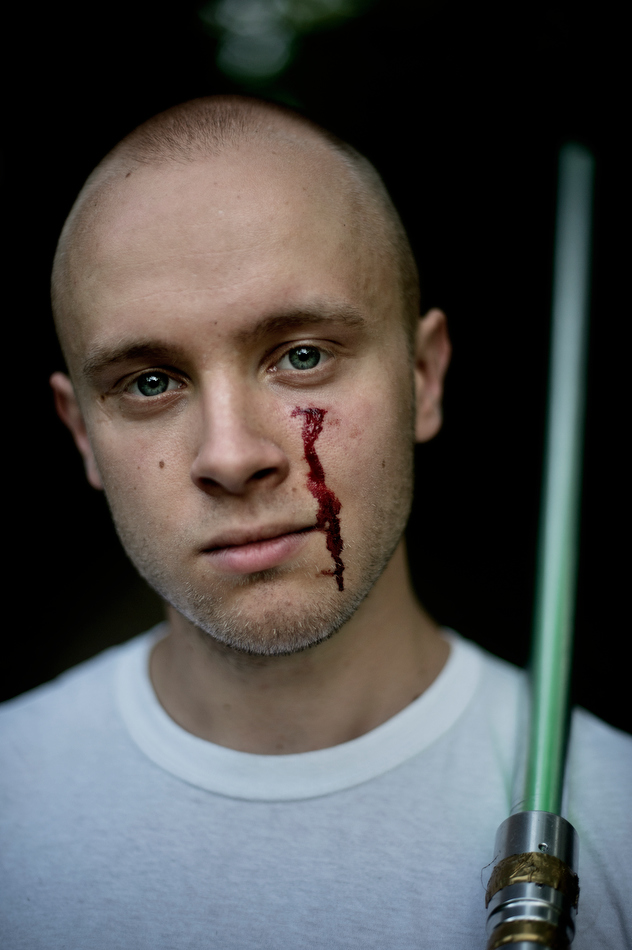
EDITOR'S NOTE: The staff at Midland Daily News just won third place in the editing category in the Pictures of the Year International competition
for newspapers. The staff at Midland consistently does wonderful community-based work, and each staff member has graciously agreed to be interviewed.
for newspapers. The staff at Midland consistently does wonderful community-based work, and each staff member has graciously agreed to be interviewed.
This is the second of three interviews.
TID:
This is an interesting and surprising image, can you please tell us the backstory?
SEAN:
First of all, thank you Ross for the opportunity to contribute to this great resource in photojournalism.
This photo is part of an essay I did about a group of kids in Midland (I say kids but they're not that much older than I am) who put on a Star Wars “L.A.W.” (Live Action Wargame). I remember talking with my co-worker Nick King after seeing something called "Lightsaber battles" on our assignment calendar. The information came from Facebook, but it sounded awesome. It read: "A local Star Wars fan club has organized a fun social event for fans and non-fans of all ages. We meet in parks and parking lots around the area and arrange massive lightsaber battles and other lightsaber involved games." Along with it was some more information from Carl, who first created "The Reformed Jedi Order" while he was in high school.
I'm not ashamed to say I'm a pretty big geek. One of the big debates my parents have was if they were watching Star Trek or James Bond when my mom went into labor. For the record, I'm pretty sure it was Star Trek. Needless to say, I was excited at the prospect of people running around playing Star Wars, so I told Nick I would check it out.
TID:
When you arrived on scene, what were your first thoughts?

SEAN:
I remember pulling up to Plymouth Park, where they were meeting up, looking for something or someone to catch my eye. Since it was late April, the weather was nice and it was mostly parents with their children playing on the playground. I hoped that I would see more than just one cloaked dude carrying a telescoping plastic lightsaber, but honestly, my hopes weren't too high. I think a couple minutes later I caught a glimpse of Carl Williams as he pulled up. There were a couple telltale signs, namely Yoda on the front of his car, a brown cloak and a belt full of those telescoping plastic lightsabers. But when he opened the trunk to his car, I saw even more sabers. Some looked different, less like toys, more like real saber handles with long tubes for blades.
I'm usually a pretty quiet person when I first meet people. In fact one of my major struggles is the initial approach, but as I approached Carl, I didn't really feel uneasy. I've grown up surrounded by geeks, or nerds, whatever you want to call us. A conversation with my brothers is usually peppered with references to major shows and movies, along with short-lived, poorly-watched shows we'd seen numerous times during their countless re-airings on the Sci-Fi Channel. Instead of the usual unease, I was just excited.
I had earlier made the decision to leave my camera in the car. I had been shooting all day, would be returning to shoot in a couple hours, and I wanted a break. If I thought it was going to be just a standalone, I'd go back and grab the camera. I introduced myself to Carl, told him I had seen his Facebook message and wanted to know a more. He was ecstatic. He asked if I was going to shoot the night's events for the paper, but I told him that I wanted to join in on the fun and then come back the week after to shoot. He handed me a saber and I spent the next couple hours running around the playground, playing games of capture the flag or all out battle. Afterwards I started trying to figure out what to do with the story.
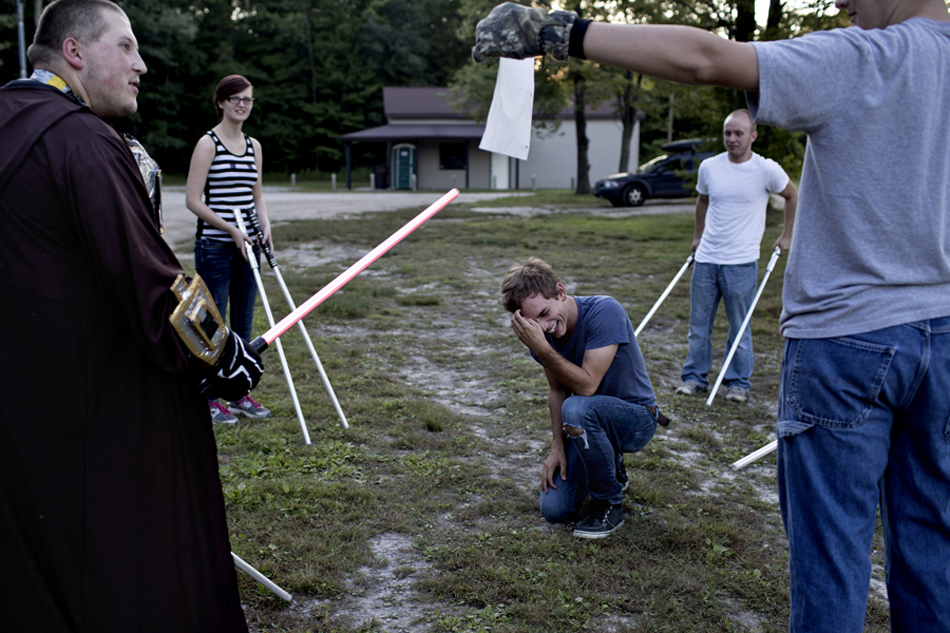
This is a picture of Sean being knighted. Photo by Sammy Jo Hester
TID:
How did you handle these thoughts and how did you proceed forward?
SEAN:
At first I wasn't sure how to approach it, beyond the battles. I was toying with ideas of following them outside of the Sunday evening events, but I ended up deciding to keep it strictly within the scope of the lightsaber battles. That was the interesting part, so why veer away from that? When I went back the next week, I told them my plan and they were cool with it. I made it a point to not just shoot, but to also take part. I would generally shoot until dark and join in the fight for a bit, or shoot one whole day and then the next time I visited, leave the camera in the car. It's not so far removed from "The Art of Listening" or how photographers normally connect with their subjects, but there were lightsabers involved.
TID:
This approach probably fits into the larger culture at your newspaper. Can you speak to how this fits in with not only your own approach but the staff's as a whole?
SEAN:
We're a staff of three at a small community newspaper in Michigan. It's simple fact that one, there are a lot of sports and two, other than sports, it gets really slow during the winter months. You have to be self-motivated to not let the very gray, dreary winters months get you down and to find something more long-term. But when we do find something, a story or an essay, that we want to work on, there are two other staffers to keep you accountable, ask how it's going and to look through edits, but to also cover for you when there's something you need to shoot. I can distinctly remember a day the Jedi were going to have a fight in the middle of Wal-Mart during the day, but we also had other 7 assignments. Nick and Neil worked around their shifts to cover them while I was able to spend the time I needed to hang out with Carl and Scott as they fought in the dairy section.

TID:
How has the staff influenced you in daily assignments like this?
SEAN:
I think the most important part of this is that we don't "keep count," or hold it against each other. We don't have a photo editor any more. The position was eliminated (making way for a third shooter) so we are only accountable to ourselves. It's understood that everything is going to come back around, and we make sure it does. Sure enough, later that week Neil had something going on for a story he was working on, and I covered for him.
Because we don't have the photo editor any more, it's also up to us to do assignment editing and page design. It's pretty interesting to lay out A1 in the morning, call on a couple assignments after coffee and then go feature hunting or put the finishing touches on a enterprise package in the afternoon. Honestly, I love that. Especially the page design. To be able to take a project from fruition to publication with full control is exciting. As a staff we've spent countless hours pouring over pictures and creating mock layouts in Photoshop before putting them on the page, and then repeating the process until midnight or later looking at the InDesign documents. Sometimes you get it right on the first try, sometimes your first try is complete crap, and after a beer, a pen and a napkin, you try again.
While whoever is on the desk is usually the one who physically lays out photo pages or packages, all three of us have a say. That can involve making small adjustments or changing the direction the layout is currently taking.
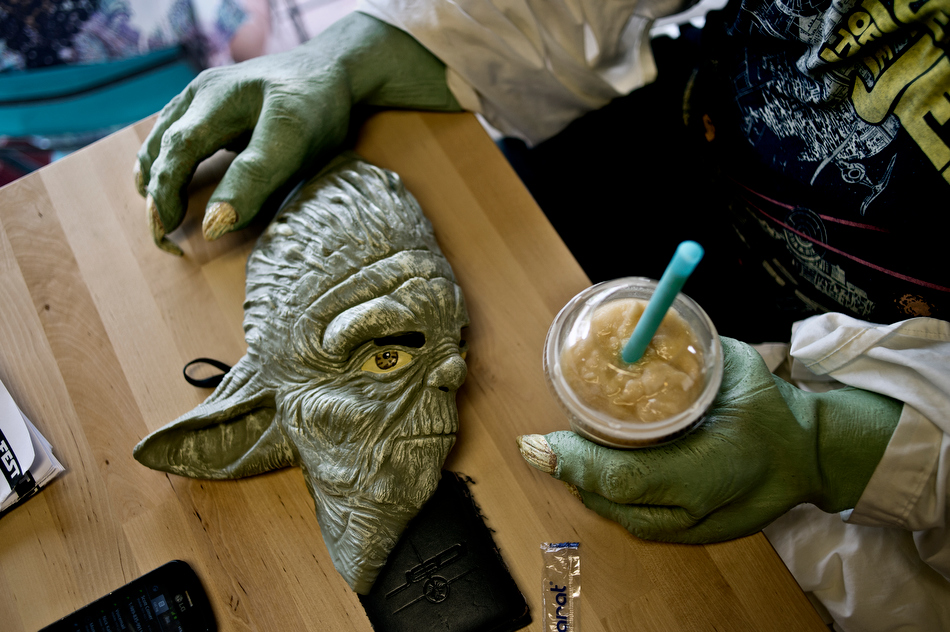
TID:
What challenges did you encounter while working in this scene?
SEAN:
None really. It was a couple visits in, everyone knew who I was and what I was doing, and I knew everyone as well. I struggled getting variety during the battles; things never really seemed to come together, because it's usually a lot more running and short skirmishes rather than all out fighting. Sometimes the major encounters would happen where I wasn't -- it all came down to shooting what I could. Because of this, I also struggled when it came down to editing for the paper. I had to be careful to not overload it with fight pictures that all said the same thing.
TID:
How did you handle and overcome these problems?
SEAN:
I tried to show at least a couple scenes that are easily recognizable to Midland while still holding onto a "fantasy" element, or something that made the viewer do a quick double take before recognizing where they were. When it came to designing, Nick and Neil really helped out by axing pictures that were cool, but similar.
TID:
Now, onto the moment. Can you talk about the moments leading up to the picture and also the actual moment?
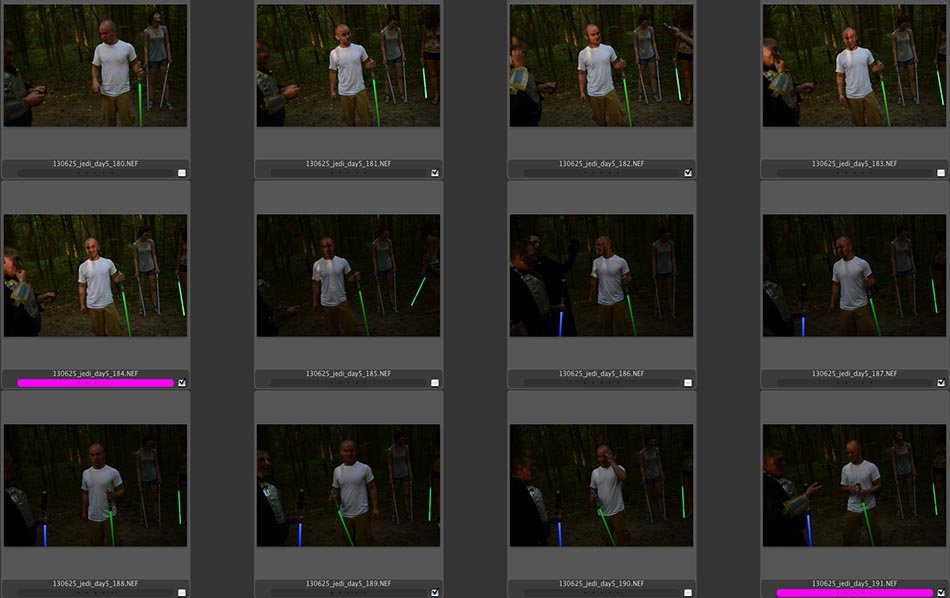
SEAN:
Most Sundays were constructed similarly. We'd all meet up and wait for stragglers. I would decide to shoot or join, and then we'd all take off into the woods. When I was shooting, I would alternate between following the "Light Side" and the "Dark Side" (for those wondering, I would play on the Dark Side.) On this particular day I started with the Light Side as they set out to find the Dark Side, who were given a couple minutes head start to find a place to hide and plan their attack.
Sometimes we'd be walking for a while, usually because the opposite side was trying to spring a trap, the success of which varied. I was hanging back with Carl and Nick (the subject of the portrait) as we walked around when the Dark Side was spotted. Nick took off to engage them in combat, while Carl made his approach more slowly. By the time Carl got there, the battle had ceased. Instead everyone had their sabers turned off and we saw Nick with blood on his face. The blade on the saber isn't sharp by any means, but due to some unlucky chance, Scott's blade managed to get Nick pretty good right below the eye. He was fine though, and decided to leave the blood to dry for the rest of the night.
The fight was all but done, so they were all standing around and talking. I immediately started to try to work the streak of blood into a picture. I worked a couple different scenes, trying to catch the slivers of light cutting through the trees as Nick walked back to the cars. As we emerged from the woods I asked to do a quick portrait of him, nothing fancy. Afterward I still tried to work the injury into pictures, trying for a more documentary-styled portrait. They all found it pretty funny, too, making jokes about Nick's bloody face making the paper rather than a picture of him locked in an epic duel. Funny enough, the portrait ended up leading A1.
It also gave me the idea to do portraits of the core group of the Reformed Jedi Order at night, lit by lightsabers, which we ran smaller on A1 to supplement Nick's.
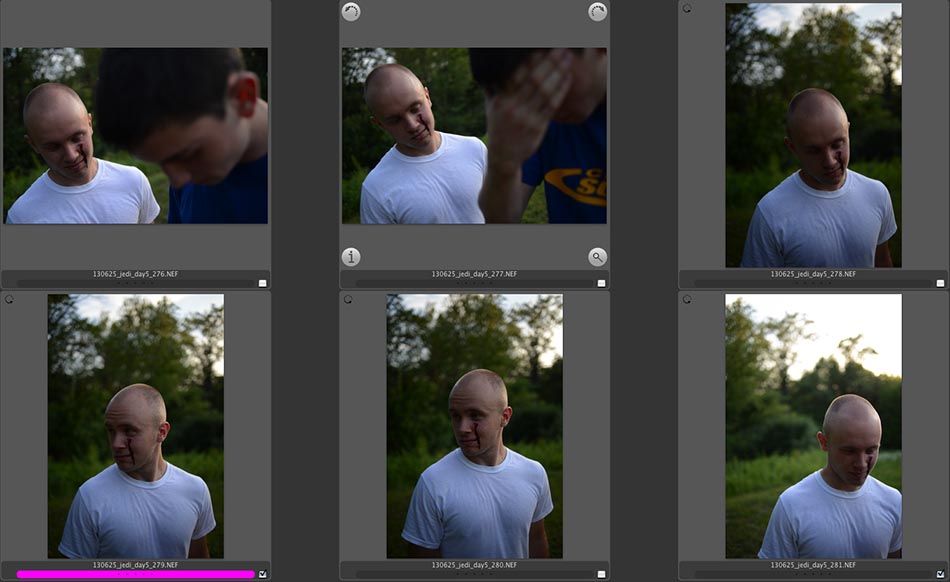
TID:
What have you learned about yourself in the process of making images like this and working on this staff?
SEAN:
I learned (or rather relearned) how awesome it is to live out these worlds and stories I've grown up watching and reading, and to work on creating my own stories about the people around me. Working on staff has taught me a lot, but I found a new appreciation for design. I love to shoot, but I also really enjoy creating an edit and putting it on the page in a dynamic way. Sometimes we keep with a pretty traditional design, but sometimes we can really flex the creatives muscles and try something new. It's something I'm still toying with, still learning every time I take a stab at it. In shooting, editing and designing you're working through all of these visual challenges of storytelling, and each one is different, creating a new set of obstacles to overcome. But they're all also closely related, so you can draw on knowledge you've gained to solve the puzzle.
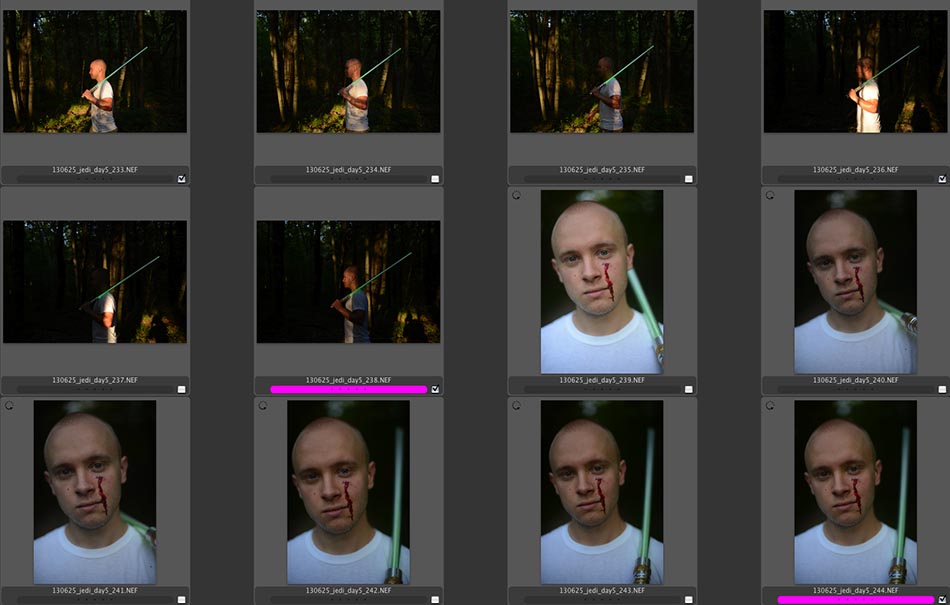
TID:
What have you learned about others?
SEAN:
Carl had this really cool quote: "Many people argue that 'The Force' isn't real. So what if I can't move objects with my mind? I'm aware of my surroundings and know my place in the universe, and that is all I need." Some might see it as silly and childish, or see it as cute, but to this group it was more than that. It was a connection they all had, and they crafted a unique shared experience around that. It's something I had done with my brothers all my life, but to find a different group of people doing the same was so much fun. And these people want their story told, to be validated. Carl said that after it published he was signing copies of the paper at work. That made me excited.
It got picked up by AP and I saw it pop up on a bunch of different newspaper websites across the US, and when I told them they were even more excited. A week after it published I went to a fight, leaving the camera in the car. We all greeted each other like usual, and then Carl said he had something for me. He got out a long cardboard box from his trunk and opened it up to reveal a new lightsaber. Black handle, red blade. He had everyone gather in a circle around me, sabers raised, and with the new saber in hand, they held a knighting ceremony -- the first official one they had done at the time. At the end I was presented with my saber, and then we fought. I still go out and hang out with them -- not as often as I did, but I make it a point to go to a fight when I can. I also ended up buying Neil Blake, my roommate and co-worker, a lightsaber for his birthday, and my brothers lightsabers for Christmas. Neil in turn got all of his siblings lightsabers for Christmas as well. It's an experience we can all share now. It is a lot of fun (and it can hurt. A lot.)
TID:
In conclusion, what advice do you have for photographers?

SEAN:
I'm still pretty new and always learning, so the idea of giving advice seems a bit silly to me. However, my good friend John Tully, who worked here a couple years back said, "Daily photojournalism is about your backyard. It's about taking time to know your community and commit to telling its stories." I completely agree with that. It's important to find your voice as a community journalist and figure out what you're trying to say about this one small section of the world you live in. Shoot what interests you even even when it's not something really serious or heavy. While I was photographing the Reformed Jedi Order, I worked on a school closing essay, a longer-term project on a six year old with cancer and a couple months later started a story on a single grandmother raising two grandkids whose house caught fire. Nick, Neil, Ryan Wood (the former MDN Photo Editor who brought me on as a freelancer while I was in school) along with some other very talented friends, push me to continually develop that voice.
As a staff we try to put ourselves in the right situations to make good pictures, tell meaningful stories and present those stories in a visually appealing way. We do that by working together every step of the way. That's probably the most important thing to me. Building a strong community strengthens your voice, style and ability to tell stories that matter to you. They'll push you, question you and cheer for you, as long as you do the same in return.
And for real. Buy lightsabers.
:::BIO:::
Sean Proctor is a 2011 graduate of Central Michigan University and is currently a staff photographer at the Midland Daily News in Midland, Michigan. Before landing at the MDN he interned at the Jackson Citizen Patriot in Jackson, Michigan and The Virginian-Pilot, in Norfolk, Virginia. While in college, he was a multimedia intern at Denali National Park in Alaska. When he's not battling Jedi in the forests, wrestling pigs at Midwestern county fairs or taking pictures of squirrels, Sean likes to enjoy a good craft beer. He's also a lover of good science fiction (in all mediums), and hopes to one day be appointed as Josiah Bartlet's presidential photographer.
You can view his work here: